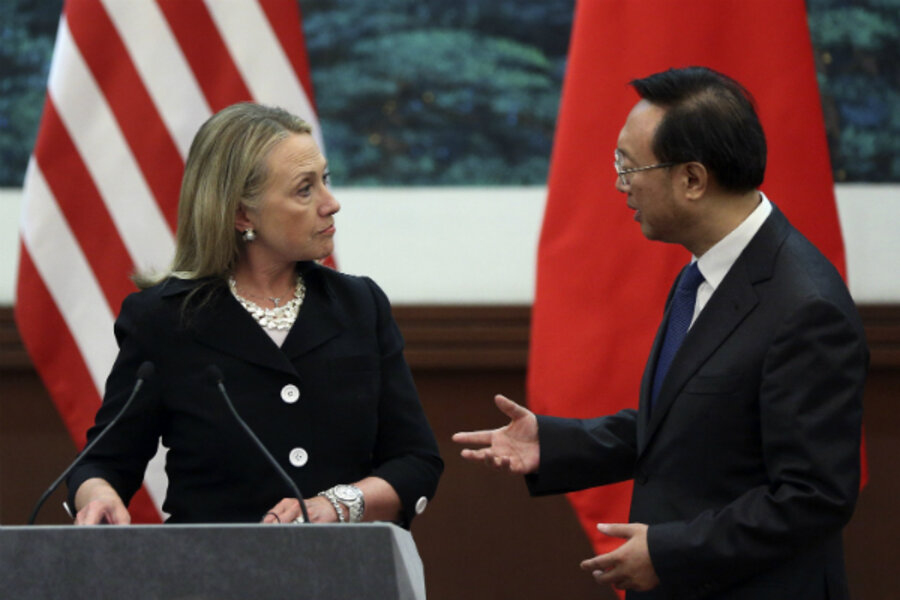China territorial disputes: a warning in the history of Imperial Japan
Loading...
| Washington
Some China scholars have begun to accuse Beijing of “salami tactics” in seeking to seize gradual control of the South China Sea. The term evokes disturbing echoes of Nazi Germany’s incremental aggression until it was ready for all-out war.
Applying World War II terminology to China’s current behavior may seem overblown, but it is apt. In fact, China’s actions also resemble those of another bad actor of that tragic period: Imperial Japan.
The emerging Japan of the 1920s and ’30s, like today’s China, was steeped in historic resentment of the West’s forcible imposition of commercial and cultural influence. Even as Western interaction hugely benefited Japan’s economy then and China’s now, both countries set about building military capabilities commensurate with their new economic prowess.
Naked military power was seen by Imperial Japan, as it is by the Communist Party in China, as necessary to defend and expand industrial achievements and economic influence against hostile Western nations, most notably the United States.
After attacking and annexing Manchuria on the basis of a minor pretext in 1931, Japanese forces extended their invasion into China proper. By the end of the 1930s, Tokyo was ready to look beyond its controlled land area comprising the home islands, Korea, Taiwan, and much of China.
On August 1, 1940, Japanese Foreign Minister Yosuke Matsuoka announced his government’s intention to establish a “Greater East Asia Co-Prosperity Sphere” under Japan’s physical and/or political control and free of Western influence. It would include the former European colonies of Southeast Asia – what Tokyo called the Southern Regions – and the Pacific Islands.
The Co-Prosperity Sphere would provide a supply of regional raw materials and energy resources to ensure Japanese self-sufficiency while enabling Japan to control the world’s access to these vital areas and commercial routes.
Mirroring the strategy of Japan’s military government prior to World War II, the newly established People’s Republic of China first consolidated its territory before venturing into wider maritime regions. In 1950, the same year it supported North Korea’s invasion of South Korea, China invaded and incorporated Tibet and East Turkestan (now Xinjiang). In 1962, it invaded India and seized territory which it still holds. In 1969, it engaged in a series of border conflicts with the Soviet Union that almost erupted into all-out war. In 1979, after Vietnam had invaded Cambodia and overthrown China’s ally, Pol Pot, China invaded northern Vietnam to “teach it a lesson” through a scorched-earth campaign.
Having dramatically increased its military and naval power, China now asserts expansive territorial and maritime claims in the East China Sea and South China Sea, maintains its longstanding claim over the Taiwan Strait, and indulges its ally North Korea’s claim to dominance in the Yellow Sea.
It has made claims in the Indian Ocean and implemented a “string of pearls” strategy of bases and diplomatic ties along the Bay of Bengal. Its submarine base and concentration of strategic naval forces near its South China Sea province of Hainan enable it to interdict shipping at the three crucial chokepoints in the Indian Ocean – Bab el Mandeb, the Strait of Hormuz, and the Strait of Malacca.
The geographic footprint of China’s claims and expanding reach in East Asia, including its strategic aspirations for the first and second island chains extending to Guam, is almost congruent to Imperial Japan’s planned map for its Co-Prosperity Sphere.
Obviously, no historic analogy is ever entirely apposite, and there are many differences between Imperial Japan in the 1930s and ’40s and China ruled by the Communist Party today. But there are more than enough parallels in strategic ambitions to awaken realistic concerns among Western policymakers and those who influence them.
As China tries its hand at a new version of a Greater East Asia Co-Prosperity Sphere, the US needs to lead a united international response that discourages further Chinese adventurism.
Washington began such an approach during the last two years of the George W. Bush administration and has accelerated this Asia “pivot” or “rebalancing” under President Obama. Secretary of State Hillary Rodham Clinton is in the region this week, building collaboration among America’s friends and allies to settle territorial disputes jointly with China, which prefers bilateral talks – a strategy that gives it the upper hand.
At a press conference in China, the secretary aptly described the US-China relationship as one in which “Our two nations are trying to do something that has never been done in history, which is to write a new answer to the question of what happens when an established power and a rising power meet.”
It’s a question that concerns a great many more countries than these two. Whether the US is led by a President Obama or President Romney, America will have to find the resources and diplomacy to continue its regional collaboration in Asia – ensuring that, this time, the outcome will be something better than war.
Lt. Gen. Wallace C. "Chip” Gregson Jr., retired, is senior director of China and the Pacific at the Center for the National Interest. He served as commander US Marine Corps Forces Pacific, and as assistant secretary of defense for Asia-Pacific security affairs from 2009-2011.
Joseph A. Bosco served in the office of the secretary of Defense as China country desk officer and previously taught graduate seminars on China-US relations at Georgetown University’s Edmund A. Walsh School of Foreign Service. He is now a national security consultant.







